101 Years of the 'Jaito Da Morcha'
A significant chapter in the peaceful efforts of Sikhs to secure the right to manage their historical gurdwaras autonomously.
101 Years of the 'Jaito Da Morcha'
As we mark the centennial, plus one, of the historic 'Jaito Da Morcha' today—coinciding with the centennial of the brutal firing by British troops on unarmed Sikh Jathas exactly 101 years ago—it is essential to reflect on and honour the bravery, resilience, and unwavering commitment of the Sikh community to their rights and religious sovereignty. This pivotal chapter in India's freedom struggle stands as a testament to the unparalleled sacrifices made by Sikhs in the fight against colonial oppression, reaffirming their pursuit of justice and the inalienable right to manage their sacred and historic gurdwaras through a democratically elected body of their own.
The Catalyst: Abdication of Maharaja Ripudaman Singh
The agitation was sparked on July 9, 1923, by the forced abdication of Maharaja Ripudaman Singh of Nabha, a progressive and popular ruler from the Phulkian misl of the Sidhu-Brar clan. Known for his candid stance on Sikh issues and his unequivocal, open support for the Akali Dal and the Gurdwara Reform Movement, his ouster by the British Government ignited unrest among Sikhs, who perceived this as an infringement on their rights and sovereignty. This incident infused new energy into the movement led by the Akali Dal, which was being coordinated from Amritsar.
Gurdwara Reform Movement and SGPC's Role
During the Gurdwara Reform Movement (1920-1925), which sought to free Sikh gurdwaras from British-backed mahants (priests)—many of whom were morally and financially corrupt—the SGPC, initially a non-statutory body, played a pivotal role. This movement was not merely a battle for control over religious sites but also a wider struggle for the Sikh community's identity and rights. The SGPC, as their own democratically elected body, along with the political entity, the Akali Dal, articulated this fight against colonial dominance.
The Prelude to the Turning Point
In the buildup to a significant turning point, an Akhand Path (a 48-hour continuous recitation of the entire Sri Guru Granth Sahib) was initiated at Gurdwara Gangsar Sahib in Jaito, located within the Princely State of Nabha and overseen by a British-appointed administrator, specifically to pray for the reinstatement of Maharaja Ripudaman Singh. The arrest of Sikh priests by colonial authorities, in an attempt to disrupt this revered spiritual ceremony, only fortified the Sikh community's determination. In a defiant response, an indefinite Akhand Path was initiated, receiving backing from the SGPC, which at the time did not yet enjoy official legal status. The situation intensified when colonial officials disrupted the ceremony by removing the holy “beed” of Sri Guru Granth Sahb. They forcibly ended the Akhand Path on September 14, 1923, and seized control of the gurdwara. As a countermeasure, the SGPC started dispatching small contingents of 25 Sikhs from Amritsar to peacefully enter the gurdwara, though these efforts were met with arrest and aggression, further highlighting the escalating tensions. Such was the response of the Sikh Sangat that the size of the jatha had soon to increased to 500 persons daily.
The Flash Point: Firing of February 21, 1924
The peaceful march towards Gurdwara Gangsar Sahib on February 21, 1924, became a watershed moment in the struggle. Ordered by the Nabha State administrator, British forces opened fire on unarmed Sikh protesters, leading to more than 150 deaths and 300 injuries, an act that drew widespread condemnation and bolstered support for the Sikh cause both nationally and internationally. The escalation culminated with a 500-member jatha being attacked by British forces, a brutal act that underscored the colonial regime's ruthlessness and marked a significant turning point in the movement for Sikh rights and sovereignty.
Jawaharlal Nehru and National Leaders' Involvement
The agitation caught the attention of national figures like Jawaharlal Nehru, whose imprisonment in Nabha jail for participating in the protests highlighted the movement's significance in the broader struggle for Indian independence. Despite being denied legal rights, Nehru's involvement underscored the interconnectedness of the Sikh struggle with the national freedom movement.
Mahatma Gandhi's Call and Support
At the urging of Mahatma Gandhi, the Congress had already passed a resolution on February 1, 1924, calling upon Hindus, Muslims, Christians, and Parsis to stand in solidarity with the Sikhs in their agitation against the British. Although specific statements from Mahatma Gandhi directly addressing the Jaito Da Morcha are not extensively documented, his steadfast commitment to non-violent resistance and the promotion of religious and civil liberties aligned closely with the spirit of the Sikh movement. Gandhi's advocacy for peaceful protest found a strong echo in the Sikh community's method of pursuing their cause.
SGPC: A Statutory Body
The relentless efforts of the Sikhs led to the formal recognition of the SGPC as a statutory body in 1925, through the Sikh Gurdwaras Act. This was a monumental achievement, granting the Sikh community the right to manage their gurdwaras democratically, without discrimination based on caste or gender—a testament to their commitment to equality and justice. The SGPC continues till date the inter-state statutory body to manage the sacred Sikh shrines and Gurdwaras within Punjab, UT Chandigarh, Himachal Pradesh and till recently, Haryana. The contentious issue of nearly 70 lakh “Sehajdhari” Sikhs allegedly disenfranchised through an amendment to the Act, currently facing legal scrutiny, however, continues to stir debate among the Sikh community, which widely regards their faith as embracing inclusivity.
Legacy, Lessons and Reflection
Summing Up: The Enduring Legacy of Jaito Da Morcha and the Current Panthic Crisis
The Jaito Da Morcha transcends its historical confines, embodying the Sikh community's unwavering resolve against oppression and its commitment to justice, freedom, and religious sovereignty. It stands as a testament to the spirit of sacrifice that has long defined the Sikh struggle—not just in securing the right to manage our historic gurdwaras, but in resisting all forms of political and religious subjugation.
As we commemorate 101 years of this landmark movement, it is imperative to reflect on the unparalleled sacrifices of our ancestors, who freed our sacred institutions from the corrupt Mahants and external control, often at the cost of their lives. Yet, today, the Sikh Panth finds itself in a deep crisis, where the Hukamnama of Sri Akal Takht Sahib is either ignored, circumvented, or outright violated by Sikh political leaders of various hues. This moment calls for serious introspection—not just to recognise past sacrifices, but to honour them in action by working toward a principled and amicable resolution of the current Panthic crisis.
The sanctity of Sri Akal Takht Sahib, the supremacy of its Hukamnamas, and the divine concept of Miri-Piri—which balances spiritual and temporal sovereignty—must be upheld at all costs. This demands a spirit of self-sacrifice and a renewed commitment to Panthic unity, so that the institutions fought for with blood and sacrifice remain truly representative of Sikh values and aspirations.
The lessons of “Jaito Da Morcha” remain profoundly relevant today, urging us to stand firm in our convictions while striving for justice, unity, and the preservation of Sikh institutions in their pristine sanctity.




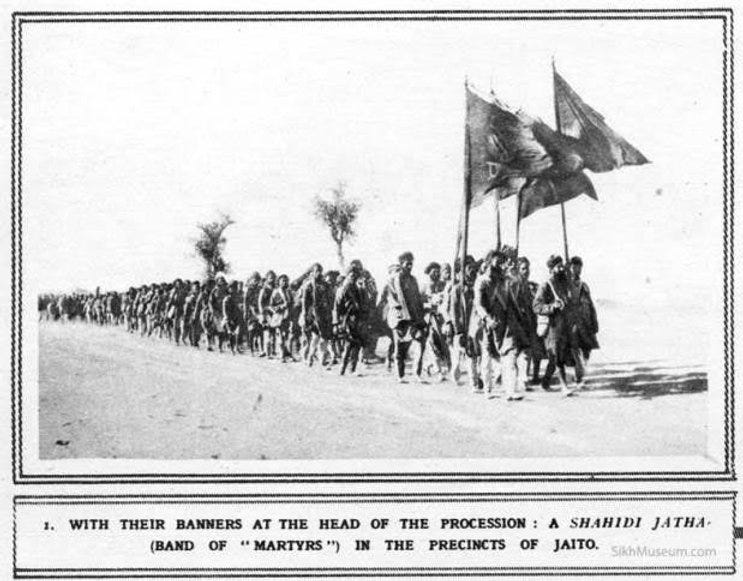
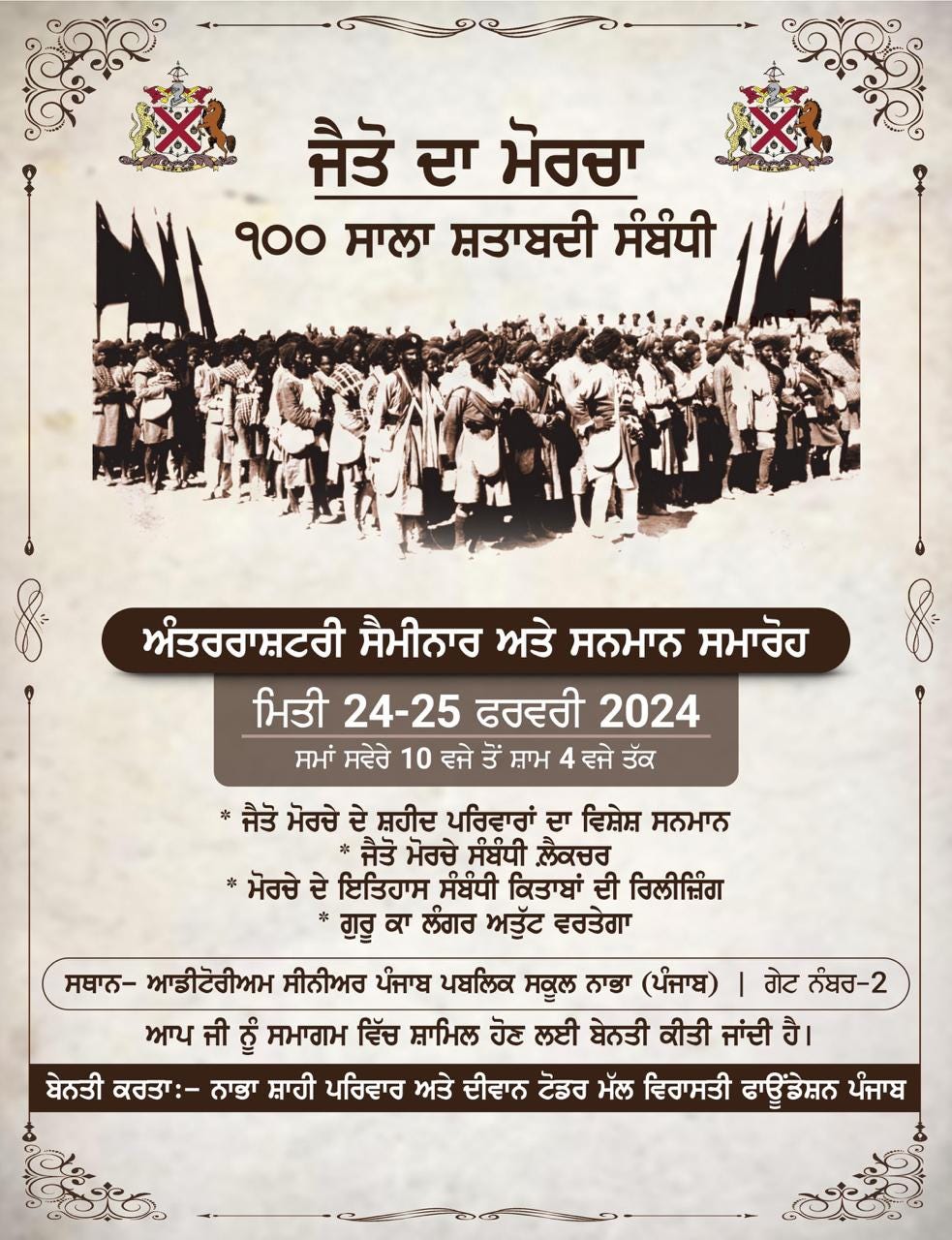
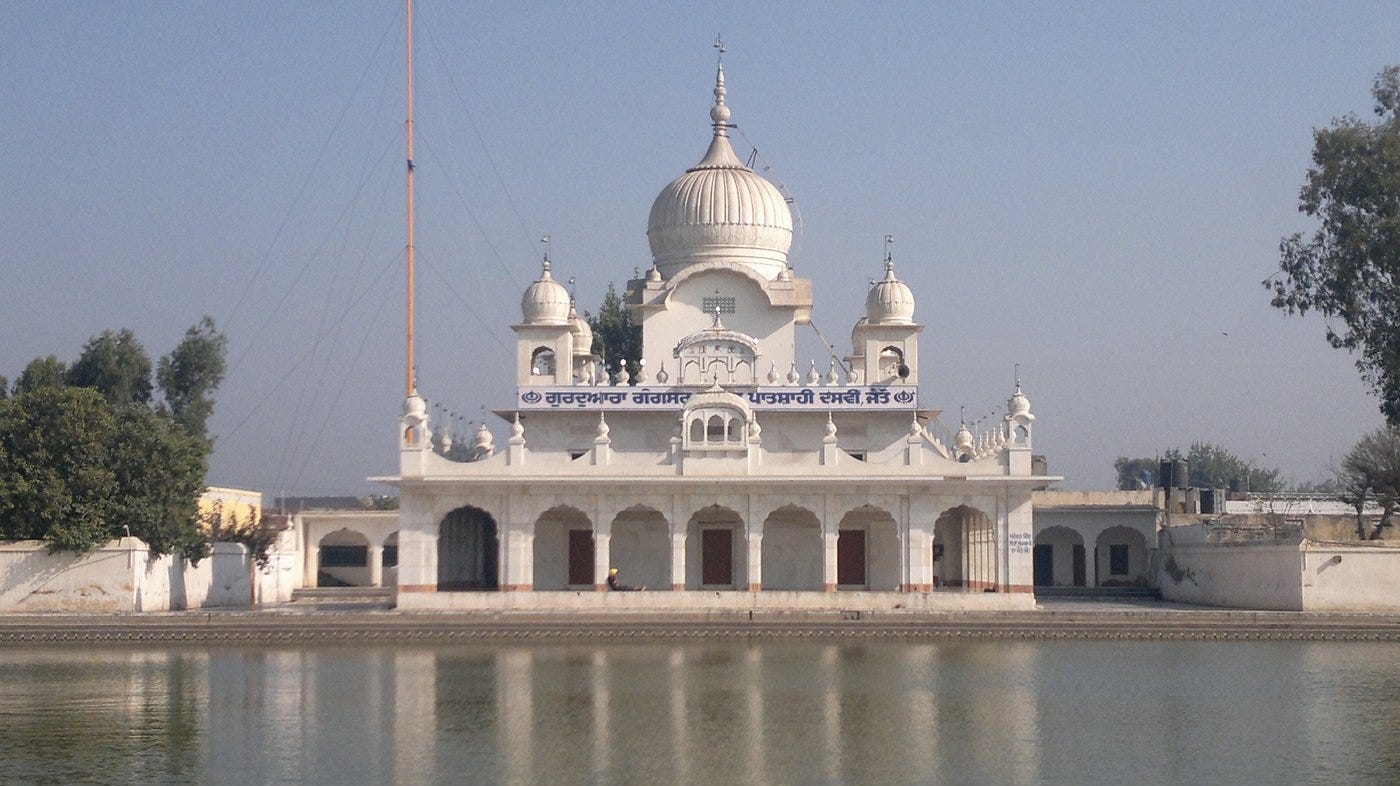
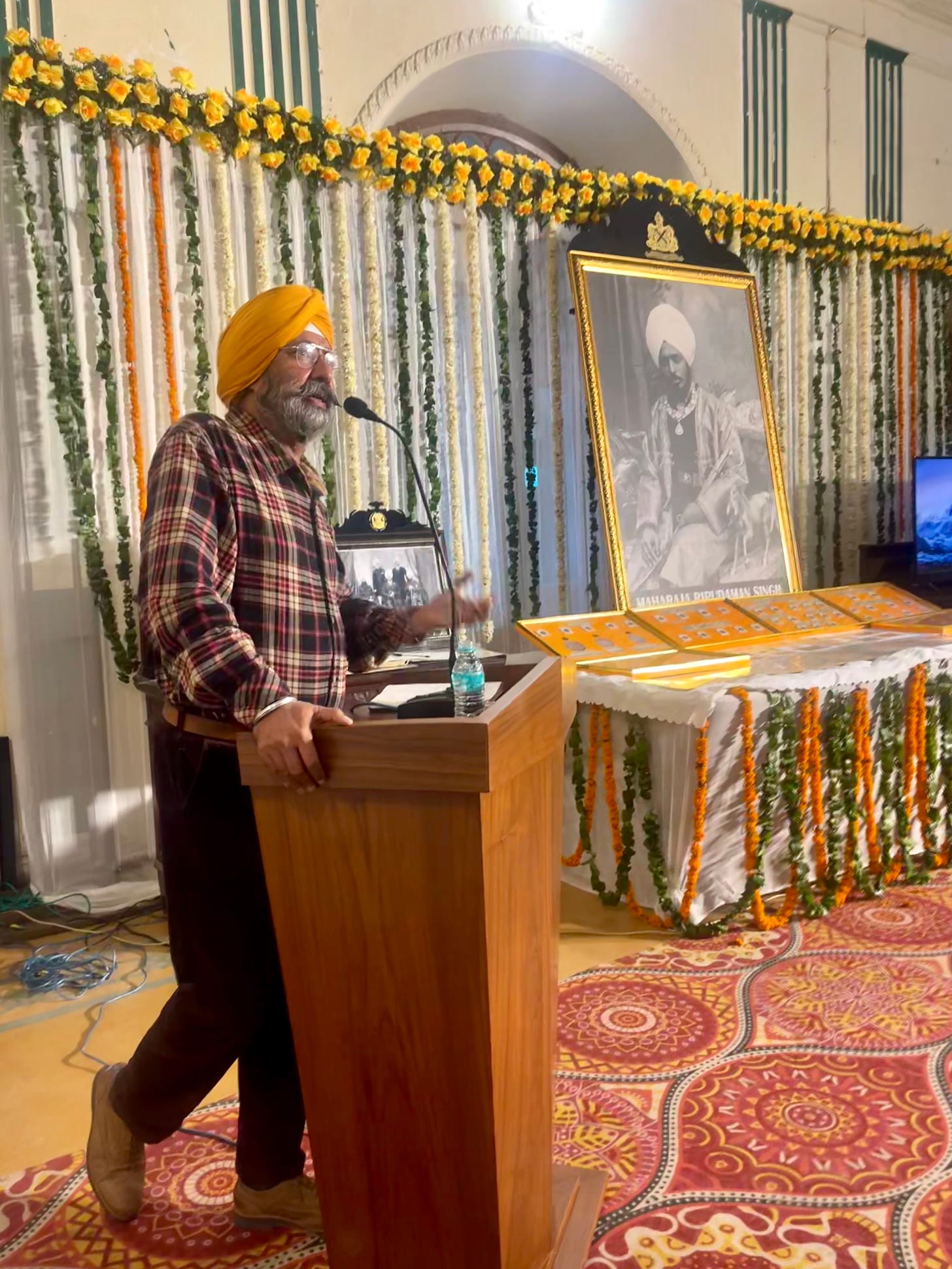
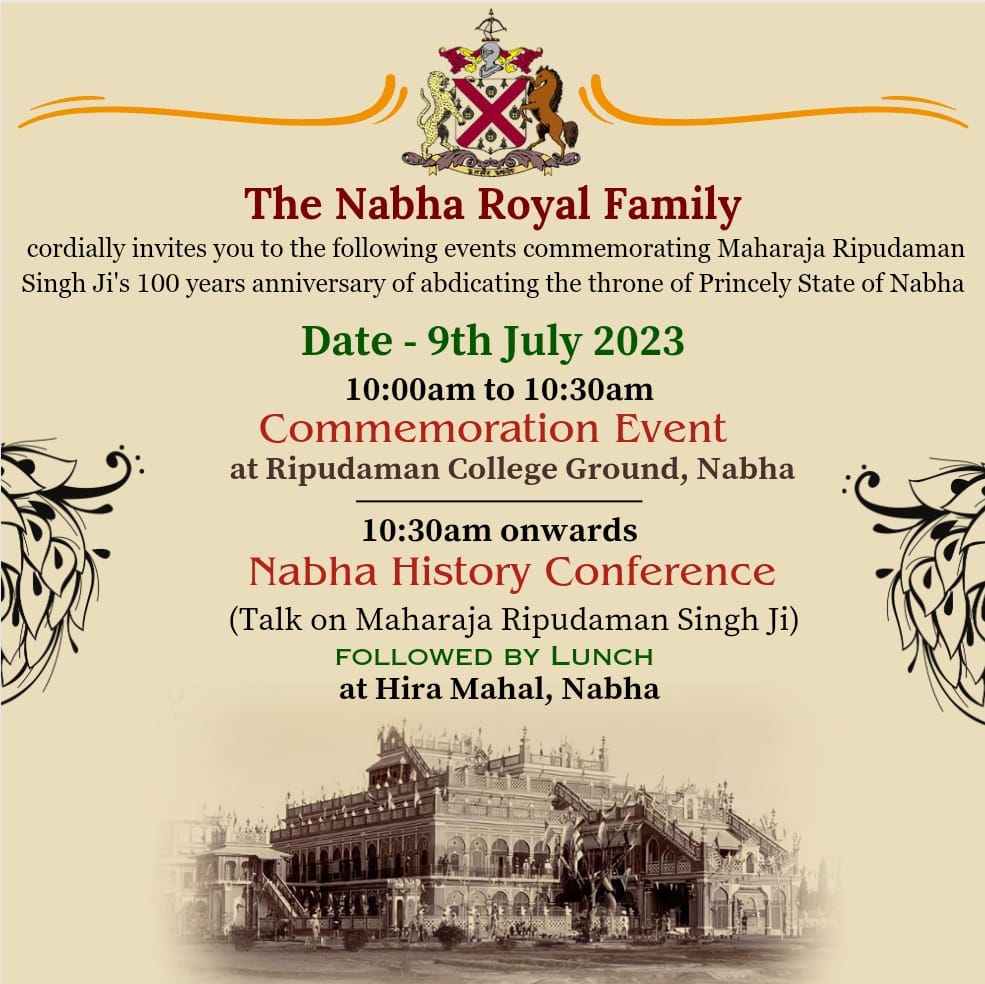


History has a way of threading itself through generations. While reading Strictly Personal: Manmohan & Gursharan by Daman Singh, I came across an interesting fact - Dr. Manmohan Singh’s father, Gurmukh Singh, also participated in Jaito Da Morcha and was imprisoned in Nabha. As someone from Jaito, I deeply understand the historical significance of this movement in Sikh history.
ਸ਼ਹੀਦਾਂ ਦੇ ਸਿਰਤਾਜ ਪੰਚਮ ਪਾਤਿਸ਼ਾਹ ਜੀ ਦੀ ਸ਼ਹੀਦੀ, ਤਿਲਕ ਜੰਝੂ ਦੇ ਰਾਖੇ ਮਹਾਂਰਾਜ ਨੌਵੇਂ ਗੁਰਦੇਵ ਜੀ ਦੀ ਸ਼ਹਾਦਤ, ਅਤੇ ਚਾਂਦਨੀ ਚੌਂਕ ਦੇ ਮਹਾਂਨ ਗੁਰਸਿੱਖਾਂ ਦੀਆਂ ਸ਼ਹਾਦਤਾਂ ਉਪਰੰਤ ਗੁਰੂ ਜੀ ਦੇ ਬਿੰਦੀ ਪੁੱਤਰਾਂ ਸਾਹਿਬਜ਼ਾਦਿਆਂ ਦੀਆਂ ਲਾਸਾਨੀ ਸ਼ਹਾਦਤਾਂ ਅਤੇ ਇਸ ਉਪਰੰਤ ਗੁਰੂ ਜੀ ਦੇ ਨਾਦੀ ਪੁੱਤਰ ਖਾਲਸੇ ਵੱਲੋਂ ਧਰਮ ਹੇਤ ਸ਼ੁਰੂ ਕੀਤੀ ਕੁਰਬਾਨੀਆਂ ਅਤੇ ਸ਼ਹਾਦਤਾਂ ਦੀ ਝੜੀ ਲਗਾਤਾਰ ਅਤੇ ਨਿਰੰਤਰ ਜਾਰੀ ਹੈ ਜੋ ਕਿ ਸਾਡੀ ਜਾਗਦੀ ਜਮੀਰ, ਸਵੈਮਾਣ,ਅਣਖ ਅਤੇ ਆਤਮਿਕ ਸੁਤੰਤਰਤਾ ਦੇ ਠਾਠਾਂ ਮਾਰਦੇ ਨਾਂ ਠੱਲੇ ਜਾਣ ਵਾਲੇ ਮਹਾਂ ਸਾਗਰ ਦੀ ਨਿਆਈਂ ਹੈ।
ਗੁਰੂ ਘਰਾਂ ਨੂੰ ਮਹੰਤਾਂ, ਮਸੰਦਾਂ ਅਤੇ ਦੁਸ਼ਟਾਂ ਦੇ ਕਬਜ਼ਿਆਂ ਤੋਂ ਮੁਕਤ ਕਰਵਾਉਣ ਲਈ ਸਾਕਾ ਨਨਕਾਣਾ ਸਾਹਿਬ, ਗੰਗਸਰ ਜੈਤੋ ਦੇ ਮੋਰਚੇ, ਸਾਕਾ ਪੰਜਾ ਸਾਹਿਬ, ਗੁਰੂ ਕੇ ਬਾਗ ਦਾ ਮੋਰਚਾ ਅਤੇ ਅਨੇਕਾਂ ਹੋਰ ਬਿਰਤਾਂਤ ਸਿਰਜ ਕੇ ਆਪਣੇ ਗੁਰੂ ਪ੍ਰਤੀ ਆਪਣੇ ਅਕੀਦੇ ਦੀਆਂ ਬਾਤਾਂ ਅਤੇ ਗੂੰਜਾਂ ਨੂੰ ਵਿਸ਼ਵ ਭਰ ਵਿੱਚ ਸੂਰਜ ਦੀ ਸਿਖ਼ਰ ਦੁਪਹਿਰੇ ਲਾਲੀ ਵਾਂਗੂੰ ਰੁਸ਼ਨਾਉਣਾਂ ਕੀਤਾ ਹੈ ਜਿਸ ਦੀ ਗਾਥਾ ਨੂੰ ਦੁਨੀਆਂ ਦੇ ਹਰ ਕੋਨੇ ਵਿੱਚ ਅਤੇ ਘਰ ਘਰ ਵਿੱਚ ਗਾਇਆ ਜਾਂਦਾ ਹੈ।
ਇਹ ਸਾਰਾ ਕੁਝ ਖਾਲਸੇ ਨੇ ਸਾਹਮਣੇ ਦਿਖਾਈ ਦਿੰਦੇ ਦੁਸ਼ਮਣ ਨਾਲ ਲੋਹਾ ਲੈਣ ਕੇ ਜਿੱਤਾਂ ਪ੍ਰਾਪਤ ਕੀਤੀਆਂ ਅਤੇ ਇਤਿਹਾਸ ਦੇ ਸੁਨਹਿਰੀ ਪੰਨਿਆਂ ਵਿੱਚ ਦਰਜ ਕਰਵਾਇਆ ਪਰ ਭੋਲੇ ਭਾਲੇ ਖ਼ਾਲਸੇ ਨੇ ਆਪਣੀ ਬੁੱਕਲ ਦੇ ਸੱਪਾਂ ਨੂੰ ਪਛਾਣਨ ਵਿੱਚ ਹਮੇਸ਼ਾਂ ਗਲਤੀਆਂ ਅਤੇ ਦੇਰੀਆਂ ਕੀਤੀਆਂ ਜਿਸ ਨਾਲ ਕੌਮ ਨੂੰ ਬਹੁਤ ਵੱਡੇ ਨੁਕਸਾਨ ਉਠਾਉਣੇ ਪਏ ਹਨ। ਮੌਜੂਦਾ ਸਮੇਂ ਵਿੱਚ ਸਤਿਗੁਰੂ ਜੀ ਦੀਆਂ ਬੇਅਦਬੀਆਂ, ਗੁਰੂ ਘਰਾਂ ਤੇ ਹਮਲੇ ਅਤੇ ਸਿੱਖ ਨੌਜਵਾਨਾਂ ਦਾ ਵਿਦੇਸ਼ੀ ਪਲਾਇਨ ਆਦਿ ਅਣਗਿਣਤ ਮਾਮਲੇ ਹਨ । ਬਾਦਲ ਪਰਿਵਾਰ ਦੇ ਸ਼੍ਰੋਮਣੀ ਗੁਰਦੁਆਰਾ ਪ੍ਰਬੰਧਕ ਕਮੇਟੀ ਤੇ ਕਬਜ਼ੇ ਨੂੰ ਖਤਮ ਕਰਨ ਲਈ ਅਜੇ ਪਤਾ ਨਹੀਂ ਕੀ ਕੁਝ ਕਰਨਾ ਪਵੇਗਾ ਜੀ।
ਨਿਸ਼ਾਨ ਸਿੰਘ ਕਾਹਲੋਂ